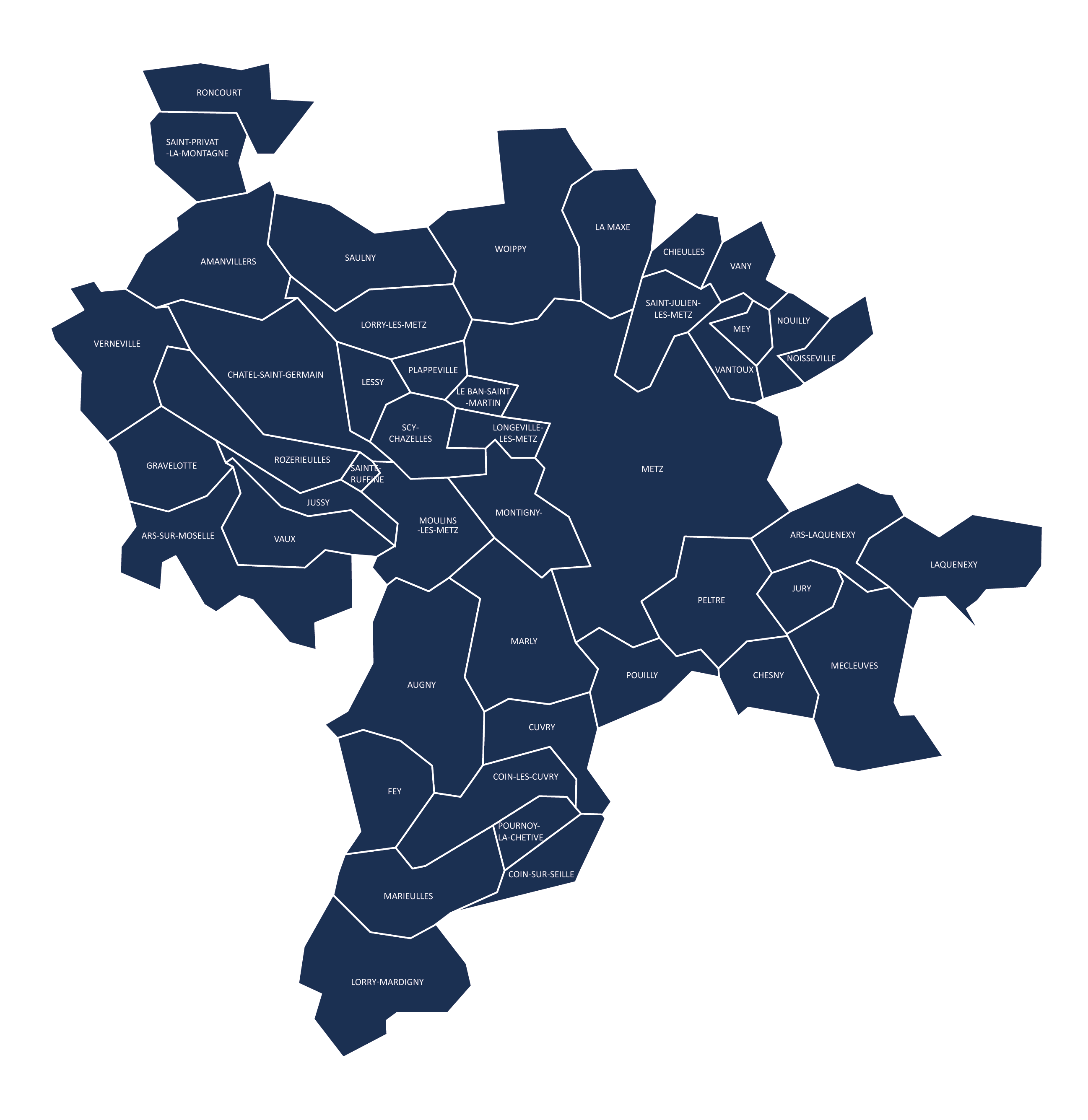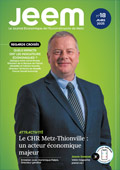Road links
The conurbation lies at the crossroads of two major motorways: the A4 and the A31.
A31: European transit function between Benelux, Luxembourg and the Rhone Valley
A4: east-west infrastructure to facilitate links with the Paris region, Luxembourg, Strasbourg and Germany.
Rail links
At the heart of the Benelux/Switzerland/Italy and France/Germany/Eastern Europe rail hub, 75 mainline trains provide daily transit for 3,000 passengers.
Since the arrival of the TGV Est high-speed train in 2007, Paris is now 85 minutes from Metz, and Paris Charles de Gaulle 71 minutes from Gare Lorraine TGV.
2,500 freight wagons are handled every day at the Woippy marshalling yard. This is the second structure of its kind in Luxembourg.
River connections
The Port of Metz is France's leading river port for cereals.
It has strong multimodal capabilities, linked by the Rhine to Rotterdam, Antwerp and the North Sea.
Annual traffic averages 4 million tonnes, making an exceptional contribution to the city's economic development and the diversification of freight transport modes.
Overhead links
Located close to the A31 and A4 freeways and the Lorraine TGV station, the Metz-Nancy-Lorraine regional airport offers scheduled, vacation and cargo flights.
However, the metropolis has 2 other airports within a 60 km radius, within 50 minutes of each other, enabling us to extend our range of destinations to intercontinental flights.
Luxembourg-Findel is 69 km or 50 minutes away, and Sarrebruck-Ensheim is 79 km or 60 minutes.

Amanvillers - Ars-Laquenexy - Ars-sur-Moselle - Augny - Châtel-Saint-Germain - Chesny - Chieulles - Coin-lès-Cuvry - Coin-sur-Seille - Cuvry - Féy - Gravelotte - Jury - Jussy - Laquenexy - La Maxe - Le Ban-Saint-Martin - Lessy - Longeville-lès-Metz - Lorry-lès-Metz - Lorry-Mardigny - Marieulles-Vezon - Marly - Mécleuves - Metz - Mey - Montigny-lès-Metz - Moulins-lès-Metz - Noisseville - Nouilly - Peltre - Plappeville - Pouilly - Pournoy-la-Chétive - Roncourt - Rozérieulles - Saint-Julien-lès-Metz - Saint-Privat-la-Montagne - Sainte-Ruffine - Saulny - Scy-Chazelles - Vantoux - Vany - Vaux - Vernéville - Woippy
A cultural and sporting metropolis
- 4 cultural establishments (Cité musicale, Opéra-Théâtre, Musée de la Cour d'Or, Centre Pompidou-Metz)
- 60,540 visitors to the Musée de la Cour d'Or in 2022
1532 students at the Conservatoire à rayonnement régional de l'Eurométropole de Metz - Infrastructures, clubs and events that put the metropolis on the map: FC Metz, Metz Handball, Metz Tennis de table, Moselle Open Euro Marathon Metz, Meeting Metz Moselle Athlelor...
A green metropolis
- 81.3% of selective collections recycled
- 84 Farmers and market gardeners on the territory
- Green and blue grid
- Blue Flag Label
- Eco-neighborhoods
A mobile metropolis
- 23.4M passengers carried on the LE MET' network in 2019
- 310 buses on the road
- 103,000 daily trips on the Le Met' network, including 46,000 daily METTIS trips
- 313 city bikes and 300 electric bikes for hire
An innovative student metropolis
- 2 local universities
- 2015 Year of French Tech certification for the region
- 3 incubators
- 1 "tiers-lieu" approved by the Grand Est region
- 5 technology transfer centers
- 23,000 students
- 26th position in the ranking of best student cities in 2024, up 6 places on 2023 (L'Étudiant).
A tourist metropolis
- A city center and an area awarded the following labels: Innovative and sustainable destination, City of Art and History, UNESCO Creative City in the Music category, tourist resort, cycling area.
- A Christmas market ranked 3rd in the "European Best Christmas Markets 2024" competition, which welcomed 3.5 million visitors in 2024*.
- More than a million people to experience summer to the rhythm of Metz's Festival International Constellations
- Over 5 million visitors to the Centre Pompidou-Metz since its opening in May 2010
- 810,451 visitors to Metz Cathedral in 2024 (+11.56%**)
- + Over 500,000 visitors to the Metz Botanical Gardens
- A cross-border, European clientele: German visitors account for over 26% of Inspire Metz - Office de Tourisme customers (1st customer group, ahead of the Grand Est region).
- 34 hotels (2024) with 2171 rooms in the Metz Eurometropole***.
- 224 *** restaurants
- Over one million overnight stays in the Metz Eurometropole
*Source: Orange Fluxvision - Metz Eurometropole
** Source: Cathédrale St Etienne metering system
*** SITLOR data
A metropolis where life is good
- Metz, 1st city to live in if you work in Paris (Le Parisien)
- Average rent including charges for housing in Metz: €594 for an average of 42.4 m², i.e. €14/m2. 3rd in the Grand Est region, behind Strasbourg and Reims.
Studies and publications
AGURAM is a research and engineering organization specializing in regional planning and development that has been supporting the Metz Eurometropolis and the Moselle region for over 50 years. It carries out studies, issue briefs and analysis to enlighten local elected officials and socio-economic players, promote partnership strategies and innovation, and take part in the debate on the city... The subjects covered are: attractiveness&economy, housing, mobility, environment, energy, climate, urban projects, planning...
Observatoire du Commerce et de la Consommation - CCI Moselle Métropole Metz/Eurométropole de Metz
The Observatoire du Commerce et de la Consommation studies the commercial zones of the Metz Eurometropole (socio-demographic profile of customers/consumer market), the commercial performance of the zones (internal attraction, sales per zone) and the purchasing behavior of households in the Metz Eurometropole.
Barometric study of Centre Pompidou-Metz audiences
The barometric study carried out each year by the Inspire Metz attraction agency and the Centre Pompidou-Metz, reveals trends in visitor numbers and highlights the economic benefits for the region.
Read the barometric study of Centre Pompidou-Metz audiences
Panorama of metropolitan employment
Every quarter, Urssaf Lorraine and AGURAM present a panorama of employment in the Metz Eurometropole, based on a range of indicators. Numbers of companies, self-employed workers and new hires: these data feed into the economic analyses produced by the agency, providing an overview of the metropolitan economy and its trends.
 Find a selection of economic indicators and rankings in JEEM magazine, 4 times a year.
Find a selection of economic indicators and rankings in JEEM magazine, 4 times a year.




